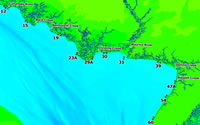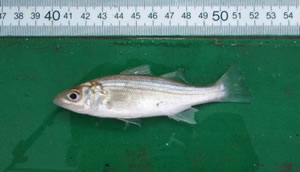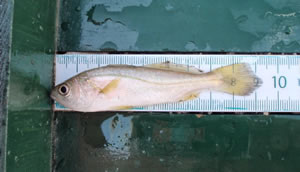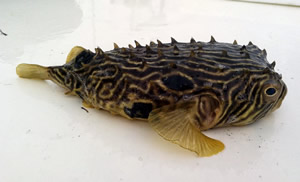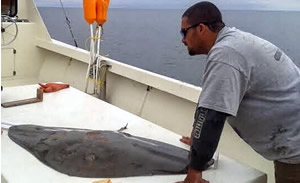by Matthew Allen, Hourly Fisheries Technician
NOTE: This article is one in the series, A Day In the Life Of a Marine Fisheries Hourly.
My early morning drive is made a little better by the sun barely peaking over the horizon, lighting up the pink sky. I arrive at the office, located at Nacote Creek in Port Republic, at 5:45 a.m. where Brian, the Senior Biologist in charge of overseeing the Delaware Bay trawl, is packing up the state vehicle. The ride to Port Norris, located on the Maurice River, takes another hour so I am able to squeeze in a quick nap before boarding the 46-foot R/V James W. Joseph. (The James W. Joseph is named in memory of former Bureau of Shellfisheries chief Jim Joseph.) We throw our bags and lunches in the cabin, put on our boots, and head out to the deck to set up for the day. For the survey we use a 16-foot otter trawl net with wooden doors (spreaders) connected on the sides to keep the net open throughout each tow. Some other equipment we will need, including bushel baskets, a sorting bucket, small buckets so we can split our catch up by species, and measuring boards, are put out on deck. We cast off, run from the bugs by retreating to the cabin, and head out for the bay. The Delaware Bay serves as feeding grounds for juvenile fish of many important recreational and commercial fish and invertebrates. The Delaware Bay Juvenile Finfish Trawl Survey was created in 1991 to mirror similar efforts by Delaware Fish and Wildlife. Data obtained from this survey is used by biologists to predict future stock population and harvest potential for a variety of keystone species along the Atlantic coast.
After the 10 minutes is up, the net is pulled in by two people on each side. Jellies squeeze through the tiny net openings and all over the deck where they slide back into the water. With a quick tug of the cord holding the cod end of our net closed the net is opened and a wave of mud, jellyfish, crabs, and juvenile fish fill our sorting bucket. This is when the fun starts! We start to sort our catch, well aware of the blue crabs snapping for our finger. In a typical pull the three most common species of fish we catch are bay anchovies, Atlantic croakers and weakfish. Each pull brings a different surprise, including an agonizing pull of almost a thousand bay anchovies no bigger than half an inch, tangled up in sea debris. A surprise guest, a 2-foot juvenile dusky shark doing everything it could to sink its razor-sharp teeth into anything that moved, was mixed in with one of our hauls as well! Once measured, we safely returned it to the water and it was able to swim off.
A list of all of the species we have caught up through 2015 can be located at www.njfishandwildlife.com/pdf/2016/artdelbay_species_totals15.pdf (pdf, 72kb)
Once our catch is sorted by species, all fish are measured in millimeters. When catches were large for a species, 50 random individuals were measured and the rest were counted. While measuring is going on, a bucket is dropped overboard to collect a water sample. We use a multi-parameter water chemistry meter to determine important aspects of the water including temperature, salinity, and dissolved oxygen saturation. Once everything is measured, we do a quick rinse to get the mud off of us and the deck, and return to the air conditioned cabin to quench our thirst and take a deserved break. Typically, we have about a 20-minute steam to the next station where we start a new haul. After five hauls and about seven hours on the water, we return to the dock and head back to the office. I'm excited to get back out there tomorrow to finish up the other six stations, but for now, all I want is my bed. |
||||||||||||||||
|
||
|
|
||
|
||
| |
||

